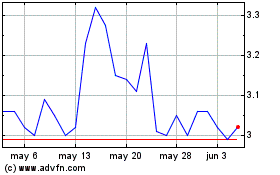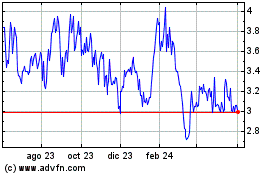eNeuro Publishes Findings on the Anti-Convulsant Properties of OV329 and Its Potential Effectiveness in Treatment-Resistant Seizures
10 Julio 2024 - 7:00AM

Ovid Therapeutics Inc. (NASDAQ: OVID), a biopharmaceutical company
dedicated to improving the lives of people affected by rare
epilepsies and brain conditions, announced that eNeuro, a
peer-reviewed, open-access journal from the Society for
Neuroscience published several preclinical studies validating
OV329’s mechanism of action and anti-convulsant properties.
OV329 is a rationally designed, next-generation
GABA-AT inhibitor in development by Ovid for the potential
treatment of drug-resistant seizures. OV329 is intended to have
higher potency and preferable safety and dosing relative to the
available medicine in this class. To support OV329’s clinical
development, the preclinical studies published in eNeuro were
conducted jointly by the Department of Neuroscience at Tufts
University School of Medicine, the Department of Neuroscience,
Physiology and Pharmacology at the University College London and
Ovid.
“These preclinical studies provide further
support that OV329 has a differentiated profile from prior
anti-convulsant therapies and may have the potential to deliver
robust and sustained seizure reduction,” said Zhong Zhong, Ph.D.,
Chief Scientific Officer of Ovid Therapeutics. “OV329 was designed
for better selectivity and improved safety relative to established
GABA-AT inhibitors. These encouraging results provide us with
further confidence of what we may hope to see in patients with
refractory seizures.”
PUBLICATION HIGHLIGHTS
- Sustained exposure to low
doses of OV329 delivered reduced GABA-AT activity and increased
GABA accumulation in mouse brains. Mice treated with OV329
at 5 mg/kg every 24 hours for six days showed significantly reduced
GABA-AT activity in the brain to 62.6 ± 4.4% of control (vehicle:
100.0 ± 2.7%; n=6 mice per experimental group; two tailed unpaired
t-test). In parallel, treatment with OV329 significantly increased
GABA levels to 134.0 ± 7.2% of control (vehicle: 100.0 ± 5.9%; n=6
mice per group; two-tailed unpaired t-test) as measured using
liquid chromatography coupled with mass spectroscopy.
- Repeat, low doses of OV329
delivered synaptic and extra synaptic inhibition in mice
suggesting it may provide sustained anti-convulsant
activity. Mice consistently treated with a low dose of 0.5
mg/kg of OV329 over six days were shown to experience phasic
(synaptic) and tonic (extra synaptic) inhibition as compared to
placebo. These findings, which were measured by
electrophysiological recordings, may differentiate OV329 from other
anti-convulsant medicines and suggest the potential to provide
broad inhibitory neurotransmission.
-
Sustained doses of OV329 reduced the severity of status
epilepticus (SE) and prevented development of benzodiazepine
resistance in a mouse model with similarities to SE
patients. In a kainic acid-induced SE mouse model, which
has similarities to patients in a state of SE, electroencephalogram
(EEG) recordings demonstrated that OV329 significantly reduced the
EEG power of SE when compared with placebo (vehicle: 2.0 ± 0.3
times 10-6 V2 compared to OV329: 0.9 ± 0.2 times 10-6 V2;
two-tailed Welch’s t test; p=0.005; N=6 mice). Additional findings
using this benzodiazepine resistant model showed that mice
pre-treated with OV329 were able to restore the anti-convulsant
effects of diazepam.
-
OV329 was shown to have superior potency (as measured by
IC50) to the GABA-AT target than
published results for vigabatrin (VGB). OV239 had an IC50
of 104.1 nM for GABA-AT, while the published IC50 for VGB was 183.8
µM.
Collectively, the studies published in eNeuro
reinforce prior findings, which suggest OV329 is a potent, highly
selective GABA-AT inhibitor. OV329 appears to increase GABA levels
in animal brains through both phasic and tonic inhibition, which
indicates that it may have the potential to deliver sustained
anti-seizure properties at very low doses in humans. Additionally,
cumulative and single doses of OV329 have been shown to reduce the
severity of SE and restore the effectiveness of diazepam in an
acute benzodiazepine-resistant seizure mouse model.
The authors note that the safety profile of
OV329 is believed to differentiate it from VGB, a previously
approved GABA-AT inhibitor. VGB, has a known toxicity and is
associated with visual field loss. The underlying mechanisms of
VGB’s toxicity may result from the high daily dose, poor blood
brain barrier permeability, low activation efficiency and possible
off-target effects. OV329 was rationally designed to be more potent
and specific with the desire to avert these safety challenges.
Specifically, OV329 exhibits a marked increase (200 - 1000 fold) in
potency for GABA-AT compared to VGB, it demonstrates the potential
for faster tissue clearance than VGB but with a prolonged
pharmacodynamic effect, and it does not irreversibly inhibit
GABA-AT activity.
Full-text of the OV329 publication in eNeuro is
available here.
About OV329OV329 is a potential
next-generation GABA-AT inhibitor being developed for the potential
treatment of rare and treatment-resistant forms of epilepsy and
seizures, such as seizures associated with status epilepticus,
tuberous sclerosis complex, infantile spasms and conditions with
focal onset seizures. Low levels of GABA, the primary inhibitory
neurotransmitter in the brain, have been linked to neuronal
hyperexcitability. OV329 is believed to work by reducing the
activity of GABA-AT, thereby increasing levels of GABA in the
brain, and potentially suppressing neuronal hyperexcitability known
to cause seizures. OV329 may be a potential best-in-class GABA-AT
inhibitor.
About Ovid TherapeuticsOvid
Therapeutics Inc. is a New York-based biopharmaceutical company
that is dedicated to meaningfully improving the lives of people
affected by certain epilepsies and brain conditions with seizure
symptoms. The Company is advancing a pipeline of novel, targeted
small molecule candidates that modulate the intrinsic and extrinsic
factors involved in neuronal hyperexcitability causative of
seizures and other neurological symptoms. Ovid is developing:
OV888/GV101 capsule, a potent and highly selective Rho-associated
coiled-coil containing protein kinase 2 inhibitor capsule, for the
potential treatment of cerebral cavernous malformations and other
rare central nervous system diseases; OV329, a GABA-AT inhibitor, a
potential therapy for treatment-resistant seizures; and OV350, a
direct activator of the KCC2 transporter, for the potential
treatment of epilepsies and other psychiatric conditions. For more
information about these and other Ovid research programs, please
visit www.ovidrx.com.
Forward-Looking StatementsThis press release
includes certain disclosures by Ovid that contain “forward-looking
statements,” including, without limitation: statements regarding
the potential use and development of OV329, OV888/GV101 capsule,
and OV350; OV329’s potential best-in-class status and the ability
to become a treatment for rare and treatment-resistant forms of
epilepsy and seizures, including the potential to deliver robust
and sustained seizure reduction at very low doses in humans; the
potential potency, efficacy, safety and or tolerability of OV329;
and the potential timing of initiation of Phase 2 clinical trials
in OV329. You can identify forward-looking statements because they
contain words such as “could,” “demonstrates,” “future,” “expects,”
“hopes,” “intends,” “may,” “plans,” “potential,” “progress,” and
“shows” and similar expressions (as well as other words or
expressions referencing future events, conditions or
circumstances). Forward-looking statements are based on Ovid’s
current expectations and assumptions. Because forward-looking
statements relate to the future, they are subject to inherent
uncertainties, risks and changes in circumstances that may differ
materially from those contemplated by the forward-looking
statements, which are neither statements of historical fact nor
guarantees or assurances of future performance. Important factors
that could cause actual results to differ materially from those in
the forward-looking statements include, without limitation,
uncertainties inherent in the preclinical and clinical development
and regulatory approval processes, risks related to Ovid’s ability
to achieve its financial objectives, the risk that Ovid may not be
able to realize the intended benefits of its technology or its
business strategy, or risks related to Ovid’s ability to identify
business development targets or strategic partners, to enter into
strategic transactions on favorable terms, or to consummate and
realize the benefits of any business development transactions.
Additional risks that could cause actual results to differ
materially from those in the forward-looking statements are set
forth under the caption “Risk Factors” in Ovid’s Quarterly Report
on Form 10-Q filed with the Securities and Exchange Commission
(“SEC”) on May 14, 2024, and in future filings Ovid makes with the
SEC. Any forward-looking statements contained in this press release
speak only as of the date hereof, and Ovid assumes no obligation to
update any forward-looking statements contained herein, whether
because of any new information, future events, changed
circumstances or otherwise, except as otherwise required by
law.
Contacts
Investor RelationsGarret
Bonney617-735-6093IR@ovidrx.com
MediaRaquel
Cabo646-647-6553RCabo@ovidrx.com
Ovid Therapeutics (NASDAQ:OVID)
Gráfica de Acción Histórica
De Oct 2024 a Nov 2024

Ovid Therapeutics (NASDAQ:OVID)
Gráfica de Acción Histórica
De Nov 2023 a Nov 2024
